The code below imports the MNIST data set and trains a stacked denoising autoencoder to corrupt, encode, then decode the data. Basically I want to use this as a non-linear dimensional reduction technique. How can I access the lower dimensional features that the model is encoding so I can throw these into a clustering model? Ideally I would expect the lower dimensional features to be loops or straight lines (obviously this will not be the case in reality).
import numpy as np
import os
import sys
import tensorflow as tf
from tensorflow.examples.tutorials.mnist import input_data
mnist = input_data.read_data_sets("/tmp/data/")
def plot_image(image, shape=[28, 28]):
plt.imshow(image.reshape(shape), cmap="Greys", interpolation="nearest")
plt.axis("off")
def reset_graph(seed=42):
tf.reset_default_graph()
tf.set_random_seed(seed)
np.random.seed(seed)
def show_reconstructed_digits(X, outputs, model_path = None, n_test_digits = 2):
with tf.Session() as sess:
if model_path:
saver.restore(sess, model_path)
X_test = mnist.test.images[:n_test_digits]
outputs_val = outputs.eval(feed_dict={X: X_test})
fig = plt.figure(figsize=(8, 3 * n_test_digits))
for digit_index in range(n_test_digits):
plt.subplot(n_test_digits, 2, digit_index * 2 + 1)
plot_image(X_test[digit_index])
plt.subplot(n_test_digits, 2, digit_index * 2 + 2)
plot_image(outputs_val[digit_index])
reset_graph()
n_inputs = 28 * 28
n_hidden1 = 300
n_hidden2 = 150 # codings
n_hidden3 = n_hidden1
n_outputs = n_inputs
learning_rate = 0.01
noise_level = 1.0
X = tf.placeholder(tf.float32, shape=[None, n_inputs])
X_noisy = X + noise_level * tf.random_normal(tf.shape(X))
hidden1 = tf.layers.dense(X_noisy, n_hidden1, activation=tf.nn.relu,
name="hidden1")
hidden2 = tf.layers.dense(hidden1, n_hidden2, activation=tf.nn.relu, # not shown in the book
name="hidden2") # not shown
hidden3 = tf.layers.dense(hidden2, n_hidden3, activation=tf.nn.relu, # not shown
name="hidden3") # not shown
outputs = tf.layers.dense(hidden3, n_outputs, name="outputs") # not shown
reconstruction_loss = tf.reduce_mean(tf.square(outputs - X)) # MSE
optimizer = tf.train.AdamOptimizer(learning_rate)
training_op = optimizer.minimize(reconstruction_loss)
init = tf.global_variables_initializer()
saver = tf.train.Saver()
n_epochs = 10
batch_size = 150
with tf.Session() as sess:
init.run()
for epoch in range(n_epochs):
n_batches = mnist.train.num_examples // batch_size
for iteration in range(n_batches):
print("\r{}%".format(100 * iteration // n_batches), end="")
sys.stdout.flush()
X_batch, y_batch = mnist.train.next_batch(batch_size)
sess.run(training_op, feed_dict={X: X_batch})
loss_train = reconstruction_loss.eval(feed_dict={X: X_batch})
print("\r{}".format(epoch), "Train MSE:", loss_train)
saver.save(sess, "./my_model_stacked_denoising_gaussian.ckpt")
show_reconstructed_digits(X, outputs, "./my_model_stacked_denoising_gaussian.ckpt")
